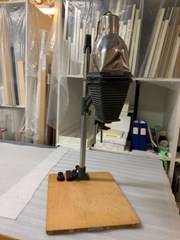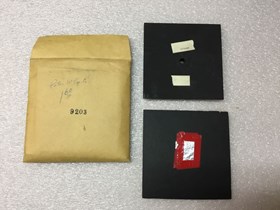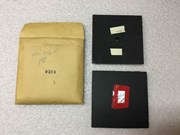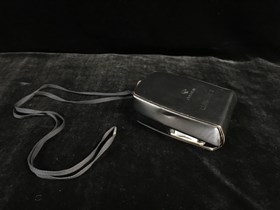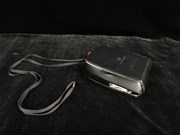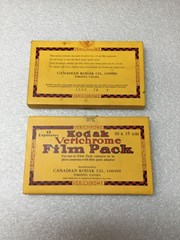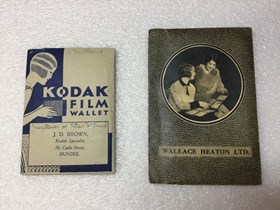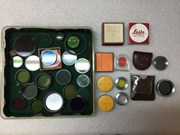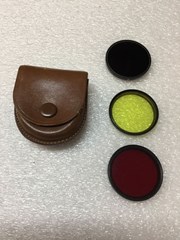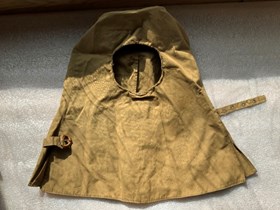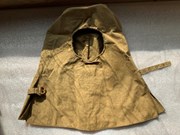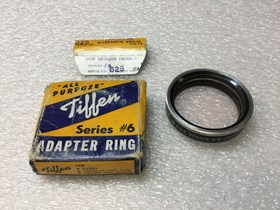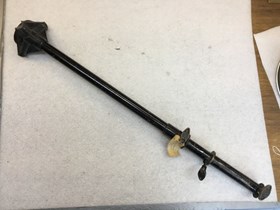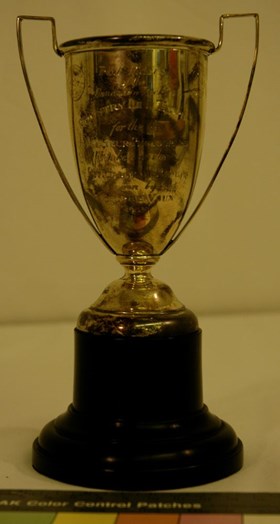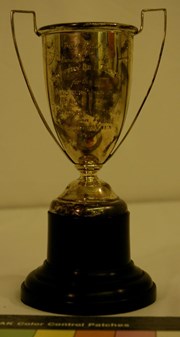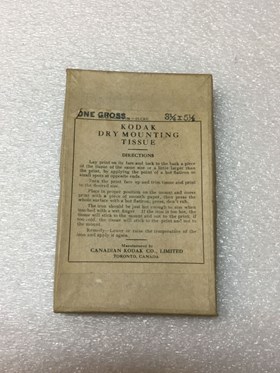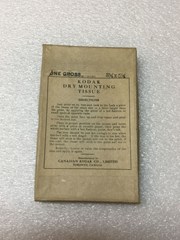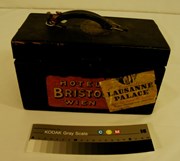Narrow Results By
- Date
- 1930 – 1950
- Material
- wood; metal; plastic; glass;
- Catalogue Number
- 104.41.0163
- Description
- Metal Kodak Precision Enlarger mounted on a wooden board with power outlets and power switch mounted beside the base of the enlarger. The support arm mostly consists of a silver metal pole onto which the dull grey metal enlarger support is mounted - a plastic knob on one side allows the enlarger su…
1 image
- Title
- Enlarger
- Date
- 1930 – 1950
- Material
- wood; metal; plastic; glass;
- Dimensions
- 105.0 x 44.5 x 55.7 cm
- Description
- Metal Kodak Precision Enlarger mounted on a wooden board with power outlets and power switch mounted beside the base of the enlarger. The support arm mostly consists of a silver metal pole onto which the dull grey metal enlarger support is mounted - a plastic knob on one side allows the enlarger support to move up and down the support arm. The enlarger itself consists of a shiny metal dome with a fabric-wrapped power cord coming out the top [most likely the house for the light source] mounted on top of the grey metal frame [to which the enlarger support is attached] and into which several different negative trays can be fit, below the frame are dark grey fabric bellows that can be adjusted along a set of metal poles, the bottom of the bellows are attached to a smaller grey metal frame that also houses the focussing lens and a coloured filter that can be rotated in and out of frame.
- Subject
- Nicholas Morant
- photography
- photograph equipment
- camera equipment
- darkroom
- photograph developing;
- Credit
- Gift of Nicholas Morant, Banff, 2006
- Catalogue Number
- 104.41.0163
Images
This material is presented as originally created; it may contain outdated cultural descriptions and
potentially offensive content.
Read more.
- Date
- 1930 – 1960
- Material
- paper; cardboard; wood;
- Catalogue Number
- 104.51.1003
- Description
- Square manilla envelope with one wooden square and one cardboard square with unknown purposes inside. The envelope has “Peter Whyte” written in cursive above “1.60” written in pencil - “9203” is stamped in black in the middle. The wooden square has a hole drilled in the middle and angled edges, mak…
1 image
- Title
- Envelope
- Date
- 1930 – 1960
- Material
- paper; cardboard; wood;
- Dimensions
- 0.5 x 11.9 x 11.9 cm
- Description
- Square manilla envelope with one wooden square and one cardboard square with unknown purposes inside. The envelope has “Peter Whyte” written in cursive above “1.60” written in pencil - “9203” is stamped in black in the middle. The wooden square has a hole drilled in the middle and angled edges, making one side a slightly smaller square than the other, and there are two small pieces of white adhesive tape, one of which has random letters and numbers typed on it [possibly a spacer for a tripod]. The cardboard square has a small hole poked in the middle and blocked off on one side with what appears to be tinfoil taped down with several layers of red adhesive tape.
- Subject
- photography
- Peter Whyte;
- Credit
- Gift of Catharine Robb Whyte, O. C., Banff, 1979
- Catalogue Number
- 104.51.1003
Images
This material is presented as originally created; it may contain outdated cultural descriptions and
potentially offensive content.
Read more.
- Date
- 1933 – 1949
- Material
- plastic; paint; leather; metal; fabric
- Catalogue Number
- 104.41.1123 a-b
- Description
- (a)Gossen Lunasix exposure and colour meter in a pear shape with leather case. The light meter device measures the amount of light that is appropriate to achieve the proper exposure, indicating for the users which shutter speed and f-number should be selected. Along the top of the exposure meter in…
1 image
- Title
- Exposure Meter
- Date
- 1933 – 1949
- Material
- plastic; paint; leather; metal; fabric
- Dimensions
- (a)2.5; (b)04.5 x (a)6.5; (b)7.5 x (a)11.5; (b)12.0 cm
- Description
- (a)Gossen Lunasix exposure and colour meter in a pear shape with leather case. The light meter device measures the amount of light that is appropriate to achieve the proper exposure, indicating for the users which shutter speed and f-number should be selected. Along the top of the exposure meter in the viewer left corner is a white bulb-like part next to an open circular window that measures the amount of light present in the scene. When the converter slide, located along the viewer right side, is moved to the right and clicked into position the round window is open and ready to read the scene. At the top, on the face of the meter, the light measurement (scale) is present. This shows how much light is present in the scene and directly relates to the remaining scales on the meter. Below the light scale is a plexiglass film-speed setting disc with grooves that allow the operator to easily move the dial. In the middle of the dial there is the Lunasix manufacturer symbol. On viewer left side of this emblem is the DIN exposure index of the film in use; on the proper right side of this emblem is the ASA exposure index of the film in use. By moving the dial one adjusts the film-speed setting, which is indicated in the DIN and ASA boxes, whereby the index number is lined up against the triangular white marker in the respective window. A manual would have originally been sold with the object giving a more comprehensive overview of the film-speed table with a technical appendix. On the rear of the object in the viewer right corner one will see the correct position of the 2 batteries indicated through a tiny diagram. Below this is a metal battery chamber. Below this are the words “2 Batt. Mallory” “PX 625 o. PX 13”. To the viewer left of this writing is the ridged slide used for battery testing. Above the ridged slide are the words “Batt. Contr.” with a solid arrow below. Below the battery information is the table of footcandle (LUX) equivalents. In the middle of the table is the zero adjustable screw with an arrow pointing in both directions. AT the very bottom painted on the surface is the location of manufacturing; “GERMANY (WEST)” above a cutout window revealing the patent number; “4D01673”. (b) There is also a black leather case with the object. The inside of the case has gray suede lining, which would have helped avoid scratching and marking of the meter. The case has been carefully designed to retrofit the meter, which is apparent through the tiny leather strap present when the case is opened. These designs allow the object to be formly held into place further safeguarding it. At the bottom of the case there is a black button that allows the case to be opened and fastened shut. When the case is fastened shut, the name of the manufacturer “Gossen” appears imprinted and is upside down. Below this, also upside down, “LUNASIX 3” has been applied in silver ink. Along the viewer right side the case has a cutout that perfectly fit the converter slide. On the rear “MADE IN GERMANY” appears in a receded box with protruding lettering. The bottom of the case, where the button is located, contains an opening for the black string to be strung through. The string, which has been tied to the exposure meter, measures 49.0 cm and has a metal piece holding the ends of the string in place. This would have given the user greater security when working with the exposure meter.
- Subject
- photography
- Nick Morant
- Credit
- Gift of Nicholas Morant, Banff, 2006
- Catalogue Number
- 104.41.1123 a-b
Images
This material is presented as originally created; it may contain outdated cultural descriptions and
potentially offensive content.
Read more.
- Date
- 1930 – 1960
- Material
- cardboard; metal;
- Catalogue Number
- 110.01.0294 a-c
- Description
- Three empty boxes for 16 mm Cine-Kodak Kodachrome and Panchromatic Safety Films. Two boxes have the empty metal film reels inside. The exteriors of the boxes are covered in product and manufacturer details and, on the back, are shipping details for when the film has been developed - two are address…
1 image
- Title
- Film Box
- Date
- 1930 – 1960
- Material
- cardboard; metal;
- Dimensions
- 2.7 x 9.8 x 9.8 cm
- Description
- Three empty boxes for 16 mm Cine-Kodak Kodachrome and Panchromatic Safety Films. Two boxes have the empty metal film reels inside. The exteriors of the boxes are covered in product and manufacturer details and, on the back, are shipping details for when the film has been developed - two are addressed from Peter Whyte in Banff and one is addressed from “MRS PETER WHYTE” in Concord.
- Credit
- Gift of Catharine Robb Whyte, O. C., Banff, 1979
- Catalogue Number
- 110.01.0294 a-c
Images
This material is presented as originally created; it may contain outdated cultural descriptions and
potentially offensive content.
Read more.
- Date
- 1930 – 1980
- Material
- leather; metal; wood; paper
- Catalogue Number
- 104.41.0093 a-h
- Description
- Hard-sided black carry case with a hinged lid and unlined wooden interior. All corners are capped with metal, mostly rusted - three metal latches are also extensively rusted (the centre one is a lock latch). Running along the length of the lid and the bottom of the case are two parallel wooden runn…
1 image
- Title
- Film Case
- Date
- 1930 – 1980
- Material
- leather; metal; wood; paper
- Dimensions
- 22.3 x 21.2 x 62.4 cm
- Description
- Hard-sided black carry case with a hinged lid and unlined wooden interior. All corners are capped with metal, mostly rusted - three metal latches are also extensively rusted (the centre one is a lock latch). Running along the length of the lid and the bottom of the case are two parallel wooden runners. Also on the lid is a hard leather handle attached to the lid with metal loops - attached to both handle loops are several remnants of paper tags and a leather travel tag with a clear plastic window. Visible through the window is a stained paper tag that reads “N Morant Special Photographer Public Relations and Advertising Canadian Pacific Banff, Alberta.” Inside the lid is a “NATIONAL FILM BOARD OF CANADA Exposed Negative” card depicting a woman in a pale green bikini. Drawn on the inside of the lid in black, yellow, and red is a caricature of a face with a thought bubble that reads “AUNT MARTHA LIKES THIS ONE.” The exterior of the case is covered in faded and torn travel stickers and labels, there is also “D7” spray painted in yellow on the lid under the handle, on both short sides, and on the back. Inside the case are three black “KODAK HARD RUBBER TANK 4x5” containers. In one tank are two cardboard boxes - one is green and contains an Eastman timer and the other is a yellow “EASTMAN THERMOMETER” box with the thermometer inside. The second tank contains two circular metal supports for developing rolls of film negatives, a white metal Kodak film canister (empty), and a blue cardboard box with another metal film processor inside. The third tank contains a cylindrical container that has something inside of it, but it does not open.
- Credit
- Gift of Nicholas Morant, Banff, 2006
- Catalogue Number
- 104.41.0093 a-h
Images
This material is presented as originally created; it may contain outdated cultural descriptions and
potentially offensive content.
Read more.
- Date
- 1930 – 1959
- Material
- leather; metal; fabric; wood
- Catalogue Number
- 104.41.0082 a-c
- Description
- Metal developing tanks dimensions: 13.6x11.6x17.2 or smaller.Torn and crinkled label free-floating inside case reads “DALLON SS TANKS 3 1/4 X 4 1/4 24 CAPACITY.” DALLON most likely refers to David Allan (Dallan) sheet metal workers, specializing in darkroom products, of London England. Case is a ha…
1 image
- Title
- Film Developer
- Date
- 1930 – 1959
- Material
- leather; metal; fabric; wood
- Dimensions
- 16.0 x 17.5 x 30.0 cm
- Description
- Metal developing tanks dimensions: 13.6x11.6x17.2 or smaller.Torn and crinkled label free-floating inside case reads “DALLON SS TANKS 3 1/4 X 4 1/4 24 CAPACITY.” DALLON most likely refers to David Allan (Dallan) sheet metal workers, specializing in darkroom products, of London England. Case is a hard-sided black leather box with a lid that hinges open and held open with a brown leather strip on the left-hand side - also has silver metal clasps and carry handle on the front of the case. The case’s interior is lined with grey fabric and the main compartment is divided into two equal sections that house the metal developing tanks. Nailed to the bottoms of each compartment are pieces of wood to prevent the tanks from sliding around. The metal tanks have lids that lift off - one has notches that could have been used to latch the lid down, but no latches remain, and the other has holes in the middle of the lid from where a handle used to be, the handle is missing. Inside the tanks are cradles with lifting handles at either end and removable curved brackets to mount the film in. One tank has what appears to be a vent with a cap on one end, the cap appears to be stuck in place. Folded-up newspaper packed into empty spaces of case beside the tanks, removed.
- Credit
- Gift of Nicholas Morant, Banff, 2006
- Catalogue Number
- 104.41.0082 a-c
Images
This material is presented as originally created; it may contain outdated cultural descriptions and
potentially offensive content.
Read more.
- Date
- 1938 – 1945
- Material
- cardboard;
- Catalogue Number
- 104.41.0204 a,b
- Description
- Two boxes of 12 10x15cm Kodak Verichrome Film Packs with broken seals. Each box is mostly yellow with black and red manufacturer and product details throughout - there are two paper adhesive stickers holding the box closed, the one that has the expiration date on it on each box is broken.Verichrome…
1 image
- Title
- Film Pack
- Date
- 1938 – 1945
- Material
- cardboard;
- Dimensions
- 1.4 x 17.9 x 10.9 cm
- Description
- Two boxes of 12 10x15cm Kodak Verichrome Film Packs with broken seals. Each box is mostly yellow with black and red manufacturer and product details throughout - there are two paper adhesive stickers holding the box closed, the one that has the expiration date on it on each box is broken.Verichrome was a kind of panchromatic film that yielded high-quality black and white photographs thanks to the fine-grained emulsion. Film Packs were basic forms of storage meant to be used shortly after purchasing as their [mostly] paper packaging did not keep out oxygen well and had a tendency to fog over time, rendering the film unusable in the long term. It was replaced by the more stable Verichrome Pan in the 1950s.
- Credit
- Gift of Robert Crosby Family, Banff, 1998
- Catalogue Number
- 104.41.0204 a,b
Images
This material is presented as originally created; it may contain outdated cultural descriptions and
potentially offensive content.
Read more.
- Date
- 1930 – 1931
- Material
- paper;
- Catalogue Number
- 104.41.0219 a,b
- Description
- Two paper folding envelopes for holding film and/or developed prints - one is Kodak and one is from Wallace Heaton Ltd., a developing studio in London England. Both wallets fold open to show two open-sided pouches where either films or prints could be slotted and have advertising for other services…
1 image
- Title
- Film Wallet
- Date
- 1930 – 1931
- Material
- paper;
- Dimensions
- 0.3 x 11.3 x 16.7 cm
- Description
- Two paper folding envelopes for holding film and/or developed prints - one is Kodak and one is from Wallace Heaton Ltd., a developing studio in London England. Both wallets fold open to show two open-sided pouches where either films or prints could be slotted and have advertising for other services/products printed on them. The Kodak wallet is predominantly white and blue, has a small slip of paper that appears to have “13/5/30 [?] Winton” and several numbers written on it in pencil, several numbers written in pencil on the left-hand side inside, and “Scotland / Negatives of Pete’s Scotland” written in black ink by Catharine Whyte on the front cover. The Wallace Heaton wallet is predominantly grey and black with a picture of two women looking at a photo album on the front cover, a slip of paper that appears to be a receipt for the Browns Hotel made out to “Nice Esq” tucking inside, “Scotland / Nice Esq / egative Scotland 1930” written in different hands on the back [everything except “Nice Esq” written by Catharine Whyte].
- Credit
- Gift of Catharine Robb Whyte, O. C., Banff, 1979
- Catalogue Number
- 104.41.0219 a,b
Images
This material is presented as originally created; it may contain outdated cultural descriptions and
potentially offensive content.
Read more.
- Date
- 1930 – 1970
- Material
- plastic; fabric; felt; leather; glass; cardboard;
- Catalogue Number
- 104.41.0212
- Description
- Square clear plastic box lined with green felt containing 26 camera filters and 2 lens caps - 6 filters are in various containers, one is unopened. Most filters were manufactured by Leitz Wetzler [the company changed its name to Leica in 1986], some are Kodak, and two are Zeiss. Filters include yel…
1 image
- Title
- Filter Box
- Date
- 1930 – 1970
- Material
- plastic; fabric; felt; leather; glass; cardboard;
- Dimensions
- 3.8 x 23.2 x 23.2 cm
- Description
- Square clear plastic box lined with green felt containing 26 camera filters and 2 lens caps - 6 filters are in various containers, one is unopened. Most filters were manufactured by Leitz Wetzler [the company changed its name to Leica in 1986], some are Kodak, and two are Zeiss. Filters include yellow, orange, red, blue, tinted, and clear patterned glass.
- Credit
- Gift of Catharine Robb Whyte, O. C., Banff, 1979
- Catalogue Number
- 104.41.0212
Images
This material is presented as originally created; it may contain outdated cultural descriptions and
potentially offensive content.
Read more.
- Date
- 1930 – 1970
- Material
- metal; glass; leather;
- Catalogue Number
- 104.41.0216
- Description
- Three colour tinted Leica lens filters in a snap-closed leather pouch - one filter is red, one yellow, one very dark red [looks black without a light behind it].
1 image
- Title
- Filter Lens
- Date
- 1930 – 1970
- Material
- metal; glass; leather;
- Dimensions
- 2.4 x 5.8 x 6.6 cm
- Description
- Three colour tinted Leica lens filters in a snap-closed leather pouch - one filter is red, one yellow, one very dark red [looks black without a light behind it].
- Credit
- Gift of Catharine Robb Whyte, O. C., Banff, 1979
- Catalogue Number
- 104.41.0216
Images
This material is presented as originally created; it may contain outdated cultural descriptions and
potentially offensive content.
Read more.
Headcovering Hood
https://archives.whyte.org/en/permalink/artifact103.04.0046
- Date
- 1933 – 1960
- Material
- fibre; skin; metal
- Catalogue Number
- 103.04.0046
- Description
- A tan coloured canvas hood or helmet which fits like a bag over the head with a round hole, approx 11 cm diam, cut through for the eyes. Crown is circular and quilted with small squares to stiffen. Hood, which completely covers head except for hole cut for eyes, is seamed down the back of the neck …
1 image
- Title
- Headcovering Hood
- Date
- 1933 – 1960
- Material
- fibre; skin; metal
- Dimensions
- 41.3 x 14.2 x 17.3 cm
- Description
- A tan coloured canvas hood or helmet which fits like a bag over the head with a round hole, approx 11 cm diam, cut through for the eyes. Crown is circular and quilted with small squares to stiffen. Hood, which completely covers head except for hole cut for eyes, is seamed down the back of the neck is attached a long 59 cm canvas belt with small leather covered buckle at one end and metal grommets at the other. Inside front panel is completely lined with the same canvas material. Hole opening on the front shows evidence of another, green and ochre coloured, piece of fabric having been cut away, possibly a camouflage cloth covering the whole thing? Black cloth label inside front panel at bottom "Sporthaus Mizzi Langer-Kauba Wien VII"
- Subject
- households
- sports
- skiing
- climbing
- Credit
- Gift of Catharine Robb Whyte, O. C., Banff, 1979
- Catalogue Number
- 103.04.0046
Images
This material is presented as originally created; it may contain outdated cultural descriptions and
potentially offensive content.
Read more.
Lantern Slide Box
https://archives.whyte.org/en/permalink/artifact104.41.1315%20a-c
- Date
- 1931
- Material
- wood; varnish; metal; paper; felt; plastic
- Catalogue Number
- 104.41.1315 a-c
- Description
- three lantern slide boxes:(a) rectangular wooden box with lid hinged on one long side and two hooks on the opposite side; Dark brown varnish coating; rabbet joinery; on one of the box small sides, there is a Dymo label with archival number: “V353 / PS 1 - 78” above a yellowed label with red frame w…
1 image
- Title
- Lantern Slide Box
- Date
- 1931
- Material
- wood; varnish; metal; paper; felt; plastic
- Dimensions
- (a) 12.0 ; (b) 12.5 ; (c) 14.4 x (a) 12.2 ; (b) 12.2 ; (c) 12.7 x (a) 32.0; (b) 32.7; (c) 33.0 cm
- Description
- three lantern slide boxes:(a) rectangular wooden box with lid hinged on one long side and two hooks on the opposite side; Dark brown varnish coating; rabbet joinery; on one of the box small sides, there is a Dymo label with archival number: “V353 / PS 1 - 78” above a yellowed label with red frame with number 19 in top left corner, circled in green and print: “LEACOCK SLIDES / 1925 - 1931 / 1 - 78”; black pen handwritten number “191” in top left corner of small side; three square compartments inside with sides padded with green felt(b) similarly built box to (a) with smaller dimensions ; Dymo label on one small side with archival number: “V353 / PS 79 - 156”; Black pen handwriting on the lid’s side: “191 LEACOCK / 79 - 156”; number 191 circled in green(c) rectangular wooden box with lid hinged on one long side and two hooks on the opposite side; dark brown varnish coating; dovetail joinery; on one of the box small sides, there is a Dymo label with archival number: “V353 / PS 157 - 234” above a yellowed label with red frame and number 19 in top left corner, circled in green and print: “LEACOCK SLIDES / 1925 - 1931 / 157 - 234”; three square compartments inside with sides padded with Bordeaux felt
- Credit
- Gift of Glenbow Archives, Calgary, 1995
- Catalogue Number
- 104.41.1315 a-c
Images
This material is presented as originally created; it may contain outdated cultural descriptions and
potentially offensive content.
Read more.
- Date
- 1935 – 1980
- Material
- metal; leather; plastic; glass; paper
- Catalogue Number
- 104.41.0089 a-s
- Description
- Leica G (Leica IIIa) black and silver camera in a brown leather case and various lenses, filters, triggers, film canister, and plastic envelope folder filled with various instruction manuals. The camera is fitted with a Leitz Elmar f=3,5cm lens with a black plastic lens cap. Also includes a “P. Ang…
1 image
- Title
- Leica Camera
- Date
- 1935 – 1980
- Material
- metal; leather; plastic; glass; paper
- Dimensions
- 8.7 x 6.7 x 14.3 cm
- Description
- Leica G (Leica IIIa) black and silver camera in a brown leather case and various lenses, filters, triggers, film canister, and plastic envelope folder filled with various instruction manuals. The camera is fitted with a Leitz Elmar f=3,5cm lens with a black plastic lens cap. Also includes a “P. Angenieux F. 90 1 : 2,5” zoom lens housed in what appears to be a homemade fabric sleeve, Leica viewfinder in a brown leather case, and three other empty lenses that house various lenses in either brown leather cases and a red fabric bag, possibly homemade.Filters include a yellow metal-mounted “KODAK SERIES VI ADAPTER RING” in a red fabric bag, metal-mounted “Series VI Kodak Pola-Screen” in a yellow Kodak cardboard box, a blue “80 - B Floods with Daylight Film” filter in a black and clear plastic box, two “Kodak Series VI color compensation” metal-ringed filters in a black and yellow “KODAK” plastic case, and three warm-toned “KODAK TYPE A COLOR FILMS” filters in individual clear plastic cases.Other accessories include extended triggers (used to minimize camera movement when taking a picture), brackets and braces for attaching the camera to a tripod, and two empty cases - one a black Leica case probably for a lens and the other a white film canister.
- Credit
- Gift of Nicholas Morant, Banff, 2006
- Catalogue Number
- 104.41.0089 a-s
Images
This material is presented as originally created; it may contain outdated cultural descriptions and
potentially offensive content.
Read more.
- Date
- 1938 – 1960
- Material
- cardboard; metal; glass;
- Catalogue Number
- 104.41.0199
- Description
- Black and silver metal Tiffen Series #6 adapter ring in the original blue and orange cardboard box.
1 image
- Title
- Lens Filter
- Date
- 1938 – 1960
- Material
- cardboard; metal; glass;
- Dimensions
- 1.6 x 5.8 x 5.3 cm
- Description
- Black and silver metal Tiffen Series #6 adapter ring in the original blue and orange cardboard box.
- Credit
- Gift of Robert Crosby Family, Banff, 1998
- Catalogue Number
- 104.41.0199
Images
This material is presented as originally created; it may contain outdated cultural descriptions and
potentially offensive content.
Read more.
- Date
- 1930 – 1960
- Material
- metal; paper;
- Catalogue Number
- 102.05.0121 a,b
- Description
- Two heavy black-painted metal stands, possibly used to hold up flood/spotlights during photo shoots. Each stand consists of a triangular base through which it appears support crossbars would be fed and two further extensions [tightened/loosened by slim diamond-shaped knobs] can be extended from the…
1 image
- Title
- Light Stand
- Date
- 1930 – 1960
- Material
- metal; paper;
- Dimensions
- 14.5 x 12.2 x 106.0 cm
- Description
- Two heavy black-painted metal stands, possibly used to hold up flood/spotlights during photo shoots. Each stand consists of a triangular base through which it appears support crossbars would be fed and two further extensions [tightened/loosened by slim diamond-shaped knobs] can be extended from the main part of the stand. All of the knobs throughout the stand have a stylized R and M overlapping inside a circle on them, but no information as to a manufacturer could be found. One stand has a faded and warped Canadian Pacific Railway travel tag attached to it by a short length of wire - the tag displays Morant’s address on both sides.
- Credit
- Gift of Nicholas Morant, Banff, 2006
- Catalogue Number
- 102.05.0121 a,b
Images
This material is presented as originally created; it may contain outdated cultural descriptions and
potentially offensive content.
Read more.
- Date
- 1931
- Material
- metal; wood
- Catalogue Number
- 103.09.1183
- Description
- Two handled silver-plated cup on black wooden circular base. Cup engraved: “Trail Riders of the Canadian Rockies Photographic Contest 1931”.
1 image
- Title
- Loving Cup
- Date
- 1931
- Material
- metal; wood
- Dimensions
- 23.0 cm
- Description
- Two handled silver-plated cup on black wooden circular base. Cup engraved: “Trail Riders of the Canadian Rockies Photographic Contest 1931”.
- Credit
- Gift of John Fee, White Rock, 1996
- Catalogue Number
- 103.09.1183
Images
This material is presented as originally created; it may contain outdated cultural descriptions and
potentially offensive content.
Read more.
- Date
- 1933
- Material
- metal; wood; fabric; paper
- Catalogue Number
- 103.09.1226
- Description
- A two-handled sterling silver trophy cup on a turned wooden base; the cup is in its original blue flannel drawstring bag. A black label with “BIRKS” in gold is stitched to the bag. The engraving on the front of the cup “Trail Riders of the Canadian Rockies” is in italic script, underneath, engraved…
1 image
- Title
- Loving Cup
- Date
- 1933
- Material
- metal; wood; fabric; paper
- Dimensions
- 18.5 x 9.2 cm
- Description
- A two-handled sterling silver trophy cup on a turned wooden base; the cup is in its original blue flannel drawstring bag. A black label with “BIRKS” in gold is stitched to the bag. The engraving on the front of the cup “Trail Riders of the Canadian Rockies” is in italic script, underneath, engraved in an arc in caps “COUNTRY LIFE TROPHY” (all other engraving is printed horizontally) lc italics “for the best”, caps “AMATEUR PHOTOGRAPHY “ lc italics “taken on the”, caps “OFFICIAL TRAIL RIDE”, lc italics “won by”, caps “GEORGE VAUX”, “1933”. The TRCR logo (a circle with a horse and rider in the centre surrounded by a rim in which “TRAIL RIDERS OF THE CANADIAN ROCKIES” is printed) is stamped on both sides of engraved “Trail Riders of the Canadian Rockies”. On the back of the cup near the lip and to the right an engraved “BIRKS” surrounded by a box, ”STERLING”, three silver hallmarks, “66/23”. The handles rise up 1.5 cm. from the lip, 1.5cm. horizontally and then curve down gracefully to the bottom of the cup at the narrowest part. The base of the cup flares out and is attached to a black turned wooden base. The bottom of base is covered by glued on black faux leather (paper).
- Subject
- sports
- riding
- horses
- Trail Riders of the Canadian Rockies
- Country Life Trophy
- George Vaux
- photography
- Credit
- Gift of Molly Vaux, New York, USA, 2007
- Catalogue Number
- 103.09.1226
Images
This material is presented as originally created; it may contain outdated cultural descriptions and
potentially offensive content.
Read more.
Mounting Tissue
https://archives.whyte.org/en/permalink/artifact104.41.0205
- Date
- 1930 – 1950
- Material
- cardboard;
- Catalogue Number
- 104.41.0205
- Description
- Plain cardboard box of 3 1/4 x 5 1/3[?] Kodak Dry Mounting Tissue held closed with a long strip of paper adhesive wrapped over the lid to the bottom of the box and a paper adhesive label on the lid displaying the manufacturer and direction of use details. Dry Mounting Tissues were a kind of adhesiv…
1 image
- Title
- Mounting Tissue
- Date
- 1930 – 1950
- Material
- cardboard;
- Dimensions
- 1.7 x 10.2 x 15.0 cm
- Description
- Plain cardboard box of 3 1/4 x 5 1/3[?] Kodak Dry Mounting Tissue held closed with a long strip of paper adhesive wrapped over the lid to the bottom of the box and a paper adhesive label on the lid displaying the manufacturer and direction of use details. Dry Mounting Tissues were a kind of adhesive used to attach a print to a support or mount [like card stock, cardboard, wood, foam core, etc] that is activated by heat and pressure. A smooth piece of paper would be laid over the print, with the tissue between the print and the support, and then a hot iron would be pressed over the whole area, melting the tissue and activating the glue. Once cool, the glue was set.
- Credit
- Gift of Robert Crosby Family, Banff, 1998
- Catalogue Number
- 104.41.0205
Images
This material is presented as originally created; it may contain outdated cultural descriptions and
potentially offensive content.
Read more.
- Date
- 1930
- Material
- skin; wood; metal; glass; paper
- Catalogue Number
- 104.41.1114 a-f
- Description
- A Cine-Kodak movie camera with a case, a lens cover, a metal spool (empty), a paper box with a tin (empty) for returning film for processing, an instruction booklet and a card for exposure times:(a) A slim compact black movie camera Model B-B with a f1.9 lens. On one side it has an oblong “OPEN” an…
1 image
- Title
- Movie Camera
- Date
- 1930
- Material
- skin; wood; metal; glass; paper
- Dimensions
- 11.5 x 5.5 x 21.0 cm
- Description
- A Cine-Kodak movie camera with a case, a lens cover, a metal spool (empty), a paper box with a tin (empty) for returning film for processing, an instruction booklet and a card for exposure times:(a) A slim compact black movie camera Model B-B with a f1.9 lens. On one side it has an oblong “OPEN” and “LOCK” mechanism in the middle and to the right it is monogrammed in gold “P.D.G”. On the opposite side is the black metal winder (to wind up the spring for film) the metal exposure tab, and the half-speed button. On the top is the carrying handle, the pop-up sight finder, the pop-up viewfinder and the indicator which moves from 50 degrees to 0. This is at the bottom of a black metal piece with silver lettering “CINE-KODAK MODEL BB MADE IN U.S.A. BY EASTMAN KODAK COMPANY ROCHESTER N.Y.”. At the other end is the lens with the focusing scale engraved for 2 to 50 ft and INF. (infinity) and the metal piece with the exposure guide screwed on “FOR CLOSE UPS IN SHADE” and a line to denote 4... to f16 “SEE MANUAL” “FOR USE IN THE TROPICS SEE MANUAL”. The camera opens on the side exposing the metal spool container the spring, the sprockets etc.(b) the leather-covered, felt-lined carrying case with a handle. The oblong shaped case is 24.0x 12.5cm wide and 14.0cm high, has compartments inside for the camera, film etc. and a hinged lid. The outside has a coloured travel sticker for “Passionsspiele Oberammergau” pasted to the the cover under the handle. To the viewer’s left a travel sticker for “Lausanne Palace”, the front “Hotel Bristol Wien” and pasted over that to the right another sticker for “Lausanne Palace”; on the right side a half-torn sticker with “AN” and underneath “IC”.(c) a black plastic and metal lens cover with “BALDA” written on it in script.(d) a yellow and black box with an empty metal film container inside. The box has the address “CANADIAN KODAK CO. LTD TORONTO 9 ONTARIO” on the front of the box on the side it has “DEVELOP BEFORE DEC. 1955”. (e) metal spool with “CINE KODAK SPOOL PAT. IN U.S.A. 1507 357”.(f) an instruction book, a booklet and a card for exposure times.
- Subject
- hobbies
- photography
- movie camera
- Credit
- Gift of Rae McIntyre, Jasper, 1985
- Catalogue Number
- 104.41.1114 a-f
Images
This material is presented as originally created; it may contain outdated cultural descriptions and
potentially offensive content.
Read more.
- Date
- 1930 – 1940
- Material
- wood; paint; glass; metal; paper; cotton; oil paint; fluid
- Catalogue Number
- 104.41.1304 a-aa
- Description
- a) blue painted wood box with metal fasteners; on the top of the box, on the viewer-left side, there is text that reads: “KODAK TRANSPARENT OIL COLORS FOR COLORING [sic] PHOTOGRAPHIC PRINTS MADE IN U.S.A. BY EASTMAN KODAK COMPANY ROCHESTER, N.Y.”, which has been directly applied onto the box with …
1 image
- Title
- Paint Box
- Date
- 1930 – 1940
- Material
- wood; paint; glass; metal; paper; cotton; oil paint; fluid
- Dimensions
- 4.0 x 14.0 x 22.5 cm
- Description
- a) blue painted wood box with metal fasteners; on the top of the box, on the viewer-left side, there is text that reads: “KODAK TRANSPARENT OIL COLORS FOR COLORING [sic] PHOTOGRAPHIC PRINTS MADE IN U.S.A. BY EASTMAN KODAK COMPANY ROCHESTER, N.Y.”, which has been directly applied onto the box with silver paint; the inside of the of the box lid has many dried paint smears of various colours on it (including: green, red, black); inside there are five main compartments of various sizes, and has not been painted so that it remains a natural wood colour; b) - p) fifteen tubes of oil paints of the following colours in the top compartment: “FLESH SHADOWS COOL”, “RAW SIENNA”, “VIOLET”, “ORANGE”, “FLESH”, “MEDIUM GREEN”, “SCARLET”, “YELLOW”, “NEUTRAL (?)”, “FLESH SHADOWS WARM”, “ROSE”, “DARK GREEN”, “OPAQUE WHITE”, “CHINESE BLUE”, “WARM BROWN”q) one ounce glass bottle of “CLEANING FLUID” in the bottom left compartment; holding clear liquid r) one ounce glass bottle of “SIZING FLUID” in the bottom left compartment; holding clear, orange-brown liquid s) - v) four wood sticks with sharpened ends in bottom right compartment; one stick has been fashioned into a skewer - cotton has been moistened and twirled around one end of the stick in order to form a rounded, cotton-tipped end; the cotton has dried red paint on its tip w) loose absorbent cotton in centre right compartment; some of which contains dried paint (red, black)x) tube of “TRANSPARENT MEDIUM” in centre right compartment (above cotton)y) 20-page long white booklet sitting flat on top of the compartments: “INSTRUCTIONS FOR USING KODAK TRANSPARENT OIL COLORS [SIC]”; sections inside the booklet include: “SELECTION OF PAPER / HOW TO USE THE COLORS / DILUENTS / APPLICATION OF COLORS / PORTRAITS / COLORING A TYPICAL PORTRAIT / COLORING HAIR / GUIDE TO COLORS [sic] AND MIXTURES / PERMANENCY”z) 28-page long silver booklet:“INSTRUCTIONS FOR USING KODAK EIGHT-TUBE OIL COLOR [sic] SET”; sections inside the booklet include: “HOW TO USE THE COLORS / PORTRAITS / COLORING PORTRAITS [sic]/ COLORING LANDSCAPES [sic] / CLEANING BORDERS / AIR BRUSH / PRESERVING AGAINST DUST AND DIRT / SEPIA TONED PICTURES / COLORING EASTMAN TRANSLITE PAPER [SIC] / LANTERN SLIDES / GUIDE TO COLORS AND MIXTURES [sic]”aa) rectangular glass palette which has dried green, purple, yellow, and white paint smears on it
- Subject
- Nicholas Morant
- photography
- Credit
- Gift of Nicholas Morant, Banff, 2006
- Catalogue Number
- 104.41.1304 a-aa
Images
This material is presented as originally created; it may contain outdated cultural descriptions and
potentially offensive content.
Read more.


